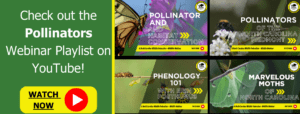Five Pollinators from North Carolina’s list of Species of Greatest Conservation Need
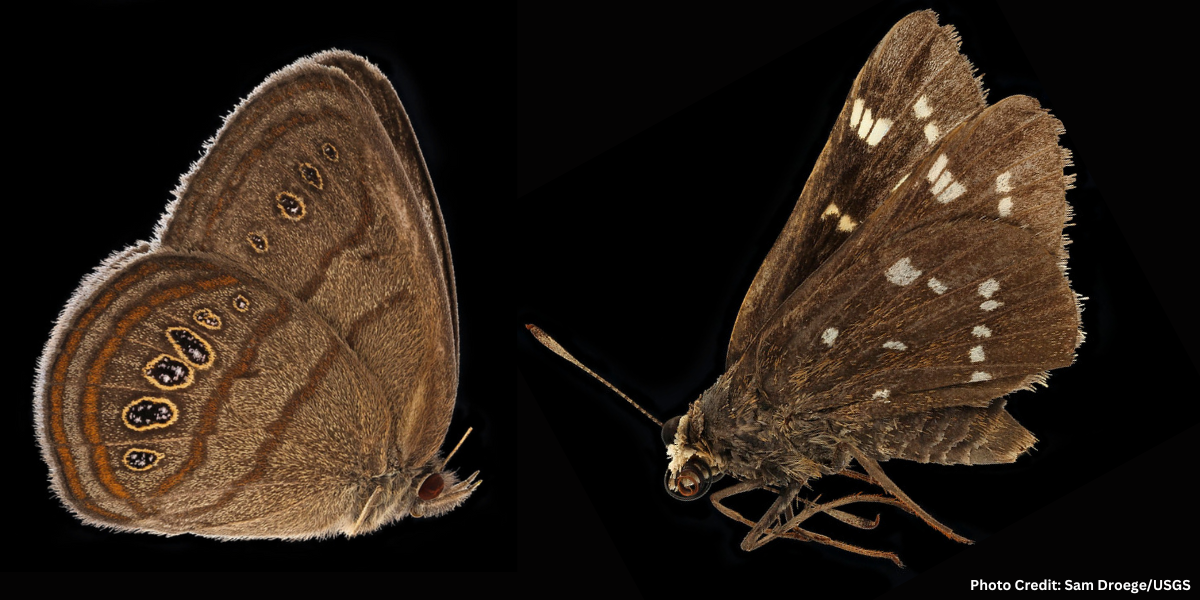
Step outside into your backyard, community garden, or a nearby city park and take in the sights, scents, sounds, and movements of the season. With temperatures on the rise and daylight hours stretching longer as we move into spring, a diverse array of plant life is poised and ready to come to life.
When in bloom, eastern columbine, resembling long maroon church bells, beckons hummingbirds to draw nectar with their specialized, pollen-bearing beaks. Hoary azalea bursts forth with starburst-like pink blossoms, inviting a flurry of butterflies and moths. Bloodroot unveils its solitary white flower just above the humus layer, welcoming beetles with ease. And before their springtime foliage unfurls, redbuds explode in hot pink, attracting bees from miles around.
Though these displays are breathtaking to us, these species aren’t blooming for mere aesthetics. They are indifferent to the beauty we find in them and the joy they bring us as the seasons shift.
No, these plants are showcasing themselves for the very creatures drawn to their vibrant, blooming, nectar-rich offerings: pollinators.
While the monarch butterfly has garnered increased attention over the years for its vital pollinating role, stunning beauty, and precarious plight, it doesn’t work alone in its pollinating prowess. A diverse array of pollinators are absolutely essential to the prosperity of plant life across our state.
Unfortunately, many of these pollinators face mounting pressures and declining populations due to habitat loss, urbanization, pollution, invasive species, and detrimental agricultural and landscaping practices.
The state’s Wildlife Action Plan, crafted by the North Carolina Wildlife Resources Commission and partners, identifies numerous pollinator species in need of conservation efforts. These species offer invaluable pollinating services to a wide range of native plant species throughout the state, including those that mitigate erosion, provide shelter for wildlife, secure our food supply, reduce climate impacts, and more.
In this blog, we focus on just a few of these pollinators facing significant threats—enough to warrant their inclusion on the state’s list of Species of Greatest Conservation Need.
Five Pollinators of Greatest Conservation Need
Crystal Skipper (Atrytonopsis quinteri)
NC Range: Eastern/Coastal
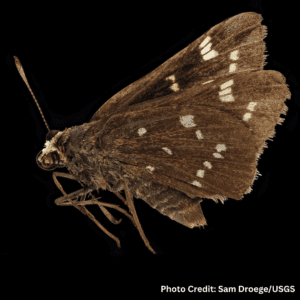 The crystal skipper exclusively inhabits the Crystal Coast of North Carolina, spanning an 85-mile stretch of coastline from Cape Lookout National Seashore to the New River (not to be confused with the New River in western NC). This species thrives particularly along a 30-mile segment between Fort Macon State Park and Hammocks Beach State Park.
The crystal skipper exclusively inhabits the Crystal Coast of North Carolina, spanning an 85-mile stretch of coastline from Cape Lookout National Seashore to the New River (not to be confused with the New River in western NC). This species thrives particularly along a 30-mile segment between Fort Macon State Park and Hammocks Beach State Park.
First classified as a distinct species in 2015, the crystal skipper heavily depends on its host plant, seaside little bluestem (Schizachyrium littorale), as well as other nectar-providing plants like yellow thistle (Cirsium horridulum) and morning-glories (Ipomoea spp.), found within the barrier island dune system.
The state parks situated at both ends of its habitat offer ample seaside little bluestem and are not slated for development in the near future. Nonetheless, coastal development, landscaping preferences, and intensified storm activity have reduced available habitat, confining the crystal skipper to small, fragmented areas.
Saint Francis’ Satyr (Neonympha mitchellii francisci)
NC Range: Piedmont (Fort Liberty)
Discovered initially in 1983 within a swamp located on the Fort Liberty (formerly Fort Bragg) military installation, the Saint Francis’ satyr has been on a precarious path toward extinction
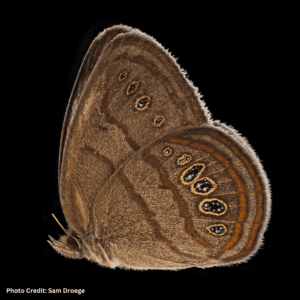
since the 1980s, leading to its federal designation as an endangered species in 1994. Access to artillery ranges on Fort Liberty, typically subjected to intense bombing and fires, granted biologists a surprising revelation in the mid-1990s: sizable populations of the Saint Francis’ satyr were thriving amidst the chaos and destruction. This phenomenon is likely attributed to the fires, which clear out trees and dense vegetation, facilitating the growth of sedges (particularly Mitchell’s sedge) and grasses—essential food sources for the satyr. Additionally, the survival of the satyr relies on beaver dams; once abandoned, these dams give rise to wet meadows where crucial food sources for the satyr flourish.
Today, Saint Francis’ satyrs are confined exclusively to a 3.38 square mile section of training fields on Fort Liberty.
Factors contributing to the limited distribution of the satyr include fire suppression, overcollection, and habitat loss resulting from historical beaver hunting and control efforts.
Appalachian Grizzled Skipper (Pyrgus centaureae wyandot)
NC Range: Western/Mountains
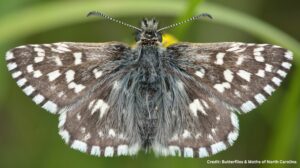 The Appalachian grizzled skipper primarily inhabits holarctic regions, mainly within the northern hemisphere, including Alaska and Canada. Nevertheless, scattered populations also occur along the Rocky Mountains, extending southward to New Mexico and also the Appalachian Mountains, branching down to North Carolina.
The Appalachian grizzled skipper primarily inhabits holarctic regions, mainly within the northern hemisphere, including Alaska and Canada. Nevertheless, scattered populations also occur along the Rocky Mountains, extending southward to New Mexico and also the Appalachian Mountains, branching down to North Carolina.
This species prefers sunny edge habitats and areas of disturbance with abundant floral resources, such as transmission lines, clearcuts, and forest edges. Appalachian grizzled skippers have been observed even colonizing newly constructed highway bypass projects, as evidenced by one isolated population discovered in Ohio.
This species relies on the dwarf cinquefoil (Potentilla canadensis) as its host plant. As a ground-dwelling plant species, Appalachian grizzled skippers have evolved to blend seamlessly into the forest floor while fluttering between patches of cinquefoil. However, when threatened by predators, it resorts to hiding within the vegetation.
Among the primary factors contributing to the decline of the Appalachian grizzled skipper is the application of pesticides, notably diflubenzuron, which is intended to control spongy moths but inadvertently affects non-target species like the skipper.
Grisatra underwing moth (Catocala grisatra)
NC Range: Eastern/Coastal
The Grisatra underwing moth may be found in the sandhills region and coastal plain of North Carolina, extending its range southward to Florida.
The decrease in the number of Grisatra underwing moths has been primarily associated with the application of harmful herbicides and loss of habitat. The establishment of pine plantations through land clearing has led to the destruction of the species host plant, hawthorns, which typically grow in the forest understory.
However, due to the scarcity of populations and the small numbers of individuals within those populations, accurately assessing the impact of management practices poses significant challenges.
Southern Plains Bumble Bee (Bombus fraternus)
NC Range: Eastern/Coastal
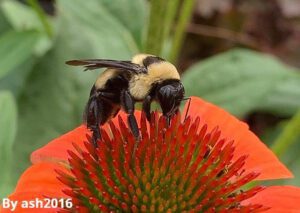 The Southern Plains bumble bee, native to Central and Southeastern North America, frequents prairies, fields, and open landscapes.
The Southern Plains bumble bee, native to Central and Southeastern North America, frequents prairies, fields, and open landscapes.
This sizable bee exhibits yellow hairs on its upper abdomen and black hairs on its lower abdomen, with colonies typically nesting either underground in abandoned rodent burrows or above ground in discarded bird nests or other available structures.
Despite its presence in eastern North Carolina, the Southern Plains bumble bee has been classified as an endangered species due to its overall population decline attributable to habitat loss and pesticide usage.
Their peak activity period extends from early to late summer, though sightings can occur from March to November.
How to Help Pollinators of Greatest Conservation Need
Addressing the needs of pollinators – and other wildlife – on the Species of Greatest Conservation Need list is a difficult task for many reasons. One of the largest difficulties in taking practical habitat improvement measures is that these species are already confined to small, isolated populations within their broader historic range.
However, providing native plant sources – particularly these species’ host plants and mitigating other threats to the species – provides them with their only real opportunity to expand their current populations into some semblance of their historic glory.
If you are located within the regions of these species and are interested in planting their host or preferred plant species, here is a good place to start:
- Crystal Skipper: Seaside little bluestem (Schizachyrium littorale)
- Saint Francis’ Satyr: Sedges – particularly Mitchell’s sedge (Carex mitchelliana)
- Appalachian Grizzled Skipper: Dwarf cinquefoil (Potentilla canadensis) and wild strawberry (Fragaria vesca)
- Grisatra Underwing Moth: Hawthorns (Crataegus)
- Southern Plains Bumblebee: Bee balm (Monarda), goldenrod (Solidago), milkweed (Asclepias), Indian blanket (Gaillardia pulchella), etc.
Register Your Yard As a Pollinator Pitstop on the Butterfly Highway
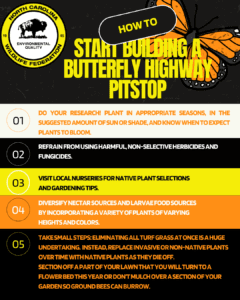 The Butterfly Highway is a statewide conservation restoration initiative that aims to restore native pollinator habitats to areas impacted by urbanization, land use change and agriculture across North Carolina. From backyard Pollinator Pitstops to large-scale roadside habitat restoration, the project is creating a network of native flowering plants to support butterflies, bees, birds and other pollen and nectar dependent wildlife.
The Butterfly Highway is a statewide conservation restoration initiative that aims to restore native pollinator habitats to areas impacted by urbanization, land use change and agriculture across North Carolina. From backyard Pollinator Pitstops to large-scale roadside habitat restoration, the project is creating a network of native flowering plants to support butterflies, bees, birds and other pollen and nectar dependent wildlife.
You can convert your yard or garden to a registered Pollinator Pitstop by taking a few simple measures to meet the essential needs for butterflies and other pollinators:
- Join/Register your garden: By registering your yard as a Pollinator Pitstop, you are committing to providing a safe place for pollinators to thrive in both adult and young stages. Your Pollinator Pitstop can be any size and there is no charge to join.
- Stay informed: Sign up to receive the weekly Butterfly Highway email newsletter, featuring Pollinator Pitstop highlights, native and invasive plant and wildlife information, and other helpful resources.
- Plant NC native pollinator seeds: Expand your current pollinator garden or start a new garden bed by including NCWF’s native pollinator seed mix. Seeds will arrive in a packet that includes a mix of at least 7 different species of native pollinator plants that support both larval and adult stages of local pollinators. Seed packets cover about 25 square feet.
- Signs on the Highway: Purchase a Butterfly Highway sign to bring your neighbors and friends onto the Highway with you.
- Support the Butterfly Highway: Your investment helps expand pollinator habitat throughout North Carolina through on-the-ground restoration projects, supporting policy that benefits pollinators, and much more.
Contact Conservation Coordinator Alden Picard at alden@ncwf.org for more info!
Want more content like this? We’ve got you covered…
Written by:

– Bates Whitaker, NCWF Communications & Marketing Manager
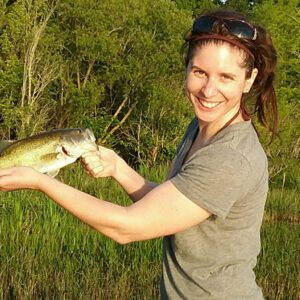
– Dr. Liz Rutledge, NCWF Director of Wildlife Resources

– Luke Bennett, Conservation Coordinator


